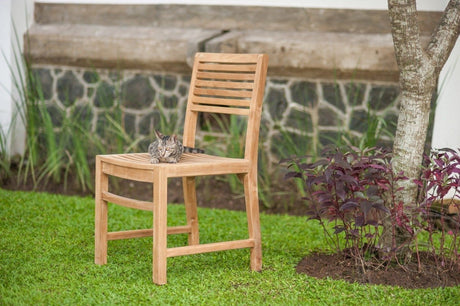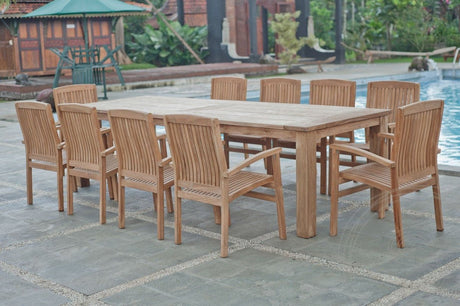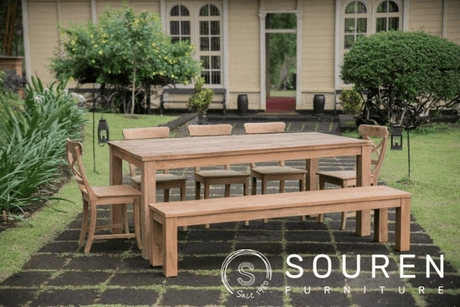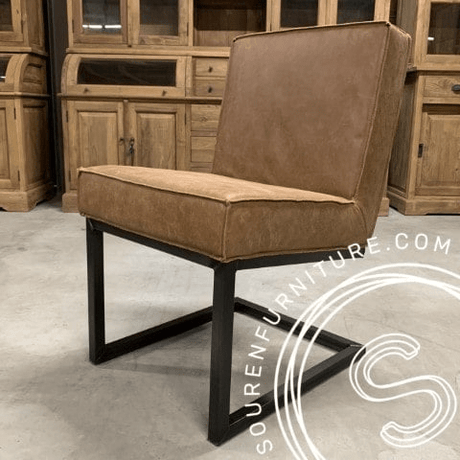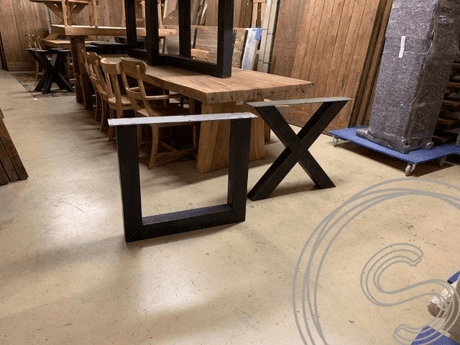Everyone knows teak of course from the furniture, garden furniture and boats that are made from it. But did you know that there are also beautiful buildings made from this natural building material? In Bangkok there is a building that is currently considered to be the largest teak building in the world. Read here fun teak information and also read more about the world's most beautiful and special teak buildings.
A brief introduction to teak
A Latin name for teak is Tectona Grandis. It is a tropical hardwood that contains oil, which makes it water-resistant and thus prevents it from rotting. It is also resistant to the influence of insects. It can be found in Indonesia, India, the Philippines, Myanmar and Malaysia. In addition to being resistant to insects and moisture, it is also very resistant to extreme weather and wind. That is why it is not only extremely popular as a raw material for furniture, but also for shipbuilding, since the Middle Ages.
The world's longest bridge made of teak wood
In Burma, a footbridge has been built that spans Lake Taungthanman. This is the U Bein Bridge, a huge attraction for the entire country. It is therefore wise to visit the bridge early in the morning, before the flow of tourists has started. The bridge, which is located 10 km south of Mandalay, is a footbridge of 1.2 kilometers long. It is named after its builder - and mayor - U Bein and has become a special piece of heritage due to its exceptional length. The frame of the bridge was made in 1849 and consists of salvaged teak beams. They come from the Amarapura palace that was demolished when the kingdom of King Mindon was moved to Manalay. The lake over which the U Bein Bridge lies is dry during the summer and fills up with water and life again during the monsoons in late summer. Under the bridge, which consists of 480 trusses and about 1000 beams, there is a paddling coming and going of ducks, fishing boats and other boats in the summer. At the bridge you can have a day and a night experience. Where everything goes quietly during the day, you will literally see the pace speed up at nightfall. You will see monks walking in their typical Crimson robes, fishermen pulling in their nets and many tourists.

If you are a tourist yourself and want to have a special experience, it is worth coming to the U Bein Bridge in the evening. Then you can take great pictures of the sunset on the bridge. In short: you will not quickly forget this special tourist attraction. Just like the people who walk around there to earn money from you. For example, you will find ladies who carry cages with them in which owls are trapped. For a dollar you can give the owls their free life back: the cages open and the little owls fly away. Then fly back to the cage, to be able to perform the same 'show' the next day! In addition to all the shows, there is fortunately enough opportunity to quietly walk over the teak bridge and admire the beauty of the construction and the nature.
The Edwin Fox: The world's oldest ship made of teak
In addition to walking on a teak bridge, you can also experience sailing on a real teak boat in Burma. In Myanmar, you can take a cruise on the Ayeyarwaddyeen River on a teak boat made by local craftsmen. The boats are shallow and are about 30 meters long. Relaxing on the boats is very easy: there are built-in lounge bars and all kinds of spaces where you can enjoy a relaxing boat trip on the river.

Nowadays, the teak ships are there for the amusement of tourists, but in the time when sailing ships were still made of teak, things were different. Back then, spices, silk and tea were transported from the east to the west with these teak ships. In addition to goods, people were also transported with the ships. For example, prisoners were transported from England to Australia. But even more poignant: slaves were also transported with these ships. Kidnapped from their African villages and sold in America to go and work in the tobacco plantations there. One such ship that transported people as well as goods was the Edwin Fox. Of a whole fleet of these types of ships, the Edwin Fox is the only one that has remained intact after all these years. The history of this boat is quite special: it was built in 1853 at the Calcutta shipyard in India. And was made entirely of teak.

The first voyage he had to make was from east to west, via the Cape of Good Hope (South Africa), from Calcutta to London. Shortly after this, the Crimean War broke out and the ship was suddenly used as a warship. When the war ended in February 1856, the Edwin Fox left Melbourne less than a month later, on its way to China. There it was used to transport goods and people between the various Chinese ports. From 1858 onwards, there were suddenly no more 'sweethearts' on the Edwin Fox: from that time on, the ship was used to transport convicts from England to Western Australia. Less than 10 years later, the ship was converted from teak into a sailing ship of the 'Barque' type. From that time on, it was used to transport immigrants from Europe to New Zealand. In 4 voyages, the Edwin Fox transported 700 families to New Zealand. The journey from Europe to the colony island took between 4 and 6 months and was more than difficult. During such a journey, all kinds of diseases developed, which caused many people to not even make the crossing. They died at sea and were therefore given a sea burial. Once they arrived in New Zealand, the conditions were not really good either. There was nothing there yet and everything had to be built up to get a better life. The chance that they would ever see their motherland again was zero. Due to the emergence of the steamship industry, sailing ships became more or less obsolete. Where the Edwin Fox first transported people, from 1880 it was used to transport New Zealand sheep. The function of an important sailing ship disappeared completely and in 1897 the ship was towed to the South Island, where it was given a new function as a floating storage. In a short time, the ship was completely stripped, all the fittings were removed and large holes were made in the side.

In the 1960s, the ship was in the way when the port of Picton was expanded. The Edwin Fox - what was left of it - was towed to Shakespeare Bay and remained there for 40 years. The teak interior was partly in the water and was slowly destroyed by nature. Parts of the ship that were still intact were destroyed by the youth of New Zealand. In 1999, the Edwin Fox Foundation made sure that they could buy the once so beautiful teak ship for a small amount. With money from the foundation, they made sure that the ship could float again and found a home again: it was towed back to Picton... The intention was to completely restore the teak ship in Picton. From replacing the high masts, to completely renovating the interior. Unfortunately, enough money was never raised to make this plan a reality. Nowadays, the hull of the Edwin Fox can still be visited as a museum. You can walk on the two decks and experience what the atmosphere was like when you were on board the ship. With the income from the tourist visits, the foundation hopes to preserve the old teak ship. The New Zealand Historic Places Trust has given the historic hull of the Edwin Fox a category 1 registration. Now the Edwin Fox Foundation is 'only' looking for enough sponsors who can finally make the restoration of this beautiful ship a reality.
The world's largest teak palace
In Thailand you will find various teak buildings that are handmade and are among the most beautiful in the world. In the past, teak was mainly used for houses, bridges and other larger buildings. Nowadays, teak is also popular in the western world, but then as a material for garden furniture, garden sheds, etc. But teak is also often used in furniture and tables for the home.

While we in the West have been impressed by teak for decades, in the East it has been a great preference for hundreds of years. It is used for furniture and buildings and can be used both indoors and outdoors. Doors made of teak last for many generations, provided that they are well maintained of course. Teak trees can grow up to 50 meters high and the higher the tree, the stronger the teak will be. In Thailand, palaces have even been built of teak. And that makes sense, because teak is a beautiful, almost royal material! In Thailand, there is the Vimanmek Palace and is the former residence of Rama V (King Chulalongkorn). It is the largest teak building built in Thailand and is a beautiful example of Thai architecture. The name of the palace literally means "Palace in the Clouds". The palace is also known as the Vimanmek Teak Mansion and is clearly influenced by Victorian architecture. The L-shaped building with 81 rooms and bedrooms is a perfect representation of how the royals lived in those days (around 1900). It is a building that was far ahead of its time: it was the first in Thailand to have a toilet, shower and electricity! Originally, the building was located in the port city of Sri Racha, where it was built. Later, it was moved to the Dusit palace complex, near the Dusit Zoo.

The Vimanmek Teak Mansion is not only very special in terms of size. It is also an exceptional palace in terms of construction: it does not consist of a single nail! This method of construction is much more common in the south of India. There you see this technique in old houses and in the furniture. The palace has not been used as a residence of the royal family since the 1930s. However, due to the good preserving properties of teak wood, it is still used as a store for royal goods. This is entirely due to the efforts of King Sikirit, who in 1982 requested permission to have the Vimanmek Royal Mansion restored to his honor. In this way, he ensured that the palace was not abandoned to its fate after the royal family left the palace. In this way, the building is also well preserved for future generations.

The Vimanmek Mansion is the largest building in the Dusit Garden palace complex. It is owned by the Royal Household, which manages and maintains the building. It now serves as a museum for tourists, who can view the king's crafts, photos and art. This national heritage is spread over 3 floors and exhibited in 31 rooms. In the bedrooms you can mainly experience the atmosphere of times gone by, in the other rooms you can mainly see a lot of splendor and pomp. Think of gifts that were given to the Thai court from all over the world. Such as ceramics, silverware, crystal glassware and tables covered with gold leaf. For a number of years, the Vimanmek Mansion has been mentioned in The Lonely Planet. This has ensured that it has become one of the most visited tourist attractions in Thailand. During a visit you will find beautiful gardens, ponds and buildings. But the performances by the Thai dancers also make a visit to the Vimanmek Mansion more than worthwhile!








